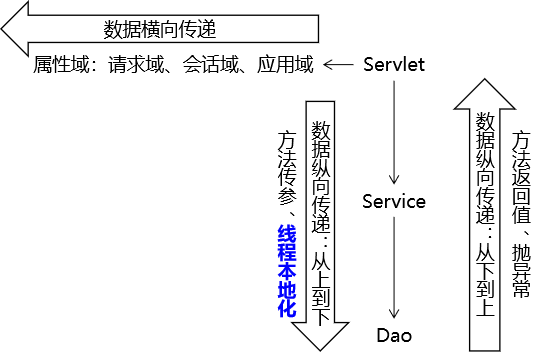第08节_属性域
1、在整个应用中属性域的重要作用

2、请求域
请求域是实际开发中使用最多的属性域,所以SpringMVC也提供了多种不同方式来操作:
①使用 Model 类型的形参
@RequestMapping("/attr/request/model")
public String testAttrRequestModel(
// 在形参位置声明Model类型变量,用于存储模型数据
Model model) {
// 我们将数据存入模型,SpringMVC 会帮我们把模型数据存入请求域
// 存入请求域这个动作也被称为暴露到请求域
model.addAttribute("requestScopeMessageModel","i am very happy[model]");
return "target";
}
②使用 ModelMap 类型的形参
@RequestMapping("/attr/request/model/map")
public String testAttrRequestModelMap(
// 在形参位置声明ModelMap类型变量,用于存储模型数据
ModelMap modelMap) {
// 我们将数据存入模型,SpringMVC 会帮我们把模型数据存入请求域
// 存入请求域这个动作也被称为暴露到请求域
modelMap.addAttribute("requestScopeMessageModelMap","i am very happy[model map]");
return "target";
}
③使用 Map 类型的形参
@RequestMapping("/attr/request/map")
public String testAttrRequestMap(
// 在形参位置声明Map类型变量,用于存储模型数据
Map<String, Object> map) {
// 我们将数据存入模型,SpringMVC 会帮我们把模型数据存入请求域
// 存入请求域这个动作也被称为暴露到请求域
map.put("requestScopeMessageMap", "i am very happy[map]");
return "target";
}
④使用原生 request 对象
@RequestMapping("/attr/request/original")
public String testAttrOriginalRequest(
// 拿到原生对象,就可以调用原生方法执行各种操作
HttpServletRequest request) {
request.setAttribute("requestScopeMessageOriginal", "i am very happy[original]");
return "target";
}
⑤使用 ModelAndView 对象
@RequestMapping("/attr/request/mav")
public ModelAndView testAttrByModelAndView() {
// 1.创建ModelAndView对象
ModelAndView modelAndView = new ModelAndView();
// 2.存入模型数据
modelAndView.addObject("requestScopeMessageMAV", "i am very happy[mav]");
// 3.设置视图名称
modelAndView.setViewName("target");
return modelAndView;
}
⑥Model、ModelMap、Map的关系
Model、ModelMap、Map类型的参数其实本质上都是 BindingAwareModelMap 类型的
public interface Model{}
public class ModelMap extends LinkedHashMap<String, Object> {}
public class ExtendedModelMap extends ModelMap implements Model {}
public class BindingAwareModelMap extends ExtendedModelMap {}
3、模型的本质[利润]
①BindingAwareModelMap
SpringMVC 传入的 Model、ModelMap、Map类型的参数其实本质上都是 BindingAwareModelMap 类型的。
②它们之间的关系

4、框架底层将模型存入请求域[利润]
①最终找到的源码位置
所在类:org.thymeleaf.context.WebEngineContext 的内部类 RequestAttributesVariablesMap
所在方法:setVariable(String name, Object value)

②过程中值得关注的点

5、会话域
使用会话域最简单直接的办法就是使用原生的 HttpSession 对象
@RequestMapping("/attr/session")
public String attrSession(
// 使用会话域最简单直接的办法就是使用原生的 HttpSession 对象
HttpSession session) {
session.setAttribute("sessionScopeMessage", "i am haha ...");
return "target";
}
6、应用域
应用域同样是使用原生对象来操作:
@Autowired
private ServletContext servletContext;
@RequestMapping("/attr/application")
public String attrApplication() {
servletContext.setAttribute("appScopeMsg", "i am hungry...");
return "target";
}
